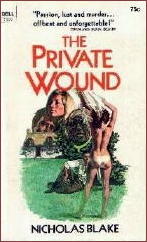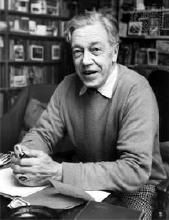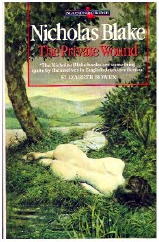Sat 14 Jun 2008
Archived Review: NICHOLAS BLAKE – The Private Wound.
Posted by Steve under Authors , Reviews[2] Comments
NICHOLAS BLAKE – The Private Wound.
Collins Crime Club, UK, hardcover, 1968. US hardcover: Harper & Row, 1968. US paperbacks: Dell, 1970 (first cover shown); Perennial, 1981. Many British paperback editions, including Pan, 1971. Australian pb: J. M. Dent, 1987 (second cover shown).

“Nicholas Blake” is an author that I’ve neglected over the years (among many), and I’m trying, with a modicum of success, to catch up with some of them. I put the author’s name in quotes, since Blake was in real life the well-known Anglo-Irish poet Cecil Day-Lewis, but as Blake, his primary sleuthing character was a fellow named Nigel Strangeways, who appeared in 16 of his 20 detective novels.
Since The Private Wound is one of the four that Strangeways is not in, I’ll refrain from saying more about the gentleman for now — it will wait until I read one that he is in — except to say that one source on the Internet mentions that primary model for Mr Strangeways was Day-Lewis’s contemporary writer and poet, W.H. Auden.
Day-Lewis was born in Ireland, and presumably had roots there all his life, which goes a long way in explaining the often poetic view of Ireland in the late 1930s there is to be found in The Private Wound. What one does not expect (or at least I did not) was the sensuality, the down-right earthiness, of the brief affair in which writer Dominic Eyre, visiting Ireland from England, finds himself enmeshed with Harry, short for Harriet, the wife of Eyre’s host, Flurry Leeson. (Flurry is short for Florence, “not an uncommon Christian name for men in Ireland.”)
Here, with your permission, is a short introductory quote, from the very first page:

Blake died in 1972, and The Private Wound was the last detective novel he wrote. His first was A Question of Proof, which appeared in 1935, which is why I think of him as a Golden Age writer. But a paragraph such as the one above could have appeared in very few novels written in the 1930s, or so I’m conditioned to believe. If I’m in error, I don’t mind, please let me know.
I’m weak on Irish history — but not as much as I was before I read this book. I knew that there was always a fierce hostility between the Irish and the English — and as Eyre soon discovers, Flurry was part of it. What I did not know was that certain factions in pre-war Ireland were seriously considering negotiations with Germany; uprisings in Ireland would seriously divert England’s attention to their west, rather than keeping their eye on what the Nazis were doing. And a conflict between Germany and England would leave the Northern counties open for takeover.
I may not have that exactly right. The book that Blake wrote is not a history book, per se, but Dominic Eyre finds himself in the thick of things, of that there is no doubt: suspected both of being a spy and by all of the neighboring countryside of cuckolding his landlord. ((As note of technical accuracy, it is Flurry’s younger brother Kevin who owns the cottage where Eyre is staying.))

In the sentence before last, the latter is true, but the former is not, and thus the story is made. It makes for a formidable tale of detection as well — I will not tell you who the victim is, and who becomes Eyre’s partner in solving the crime — and I confess that I did not know who the killer was until two pages before All Is Revealed. And I should have. Known, that is, and much earlier. All in all, nicely done, in a sad and beautifully haunting sort of way.
The same Internet source suggests that The Private Wound is considered the most autobiographical of the author’s works in the mystery genre. That may or may not be true — I have no way of knowing otherwise — but it does help explain the strange framing device. That the tale begins with “Dominic Eyre” describing the events that happened to him thirty years before is not so unusual — it was the closing short epilogue which was, when first read, the puzzler.
The title comes from The Two Gentlemen from Verona: “The private wound is deepest.”
[UPDATE] 06-14-08. I’ll be posting a review one of Blake’s detective novels with Nigel Strangeways in it sometime soon, perhaps not tomorrow, but by Monday at the latest.
June 15th, 2008 at 11:12 pm
[…] what a night and day difference there is between this book and the previous one by him, reported on here. This is the second mystery Blake wrote — the first was A Question of Proof — and […]
May 14th, 2009 at 9:15 pm
[…] had somewhat realistic hopes of using the enmity between the two countries to their own ends. (See my review of The Private Wound by Nicholas Blake for a mystery novel that also uses this small but hardly […]